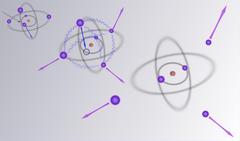URL: https://www.desy.de/news/news_search/index_eng.html
Breadcrumb Navigation
DESY News: Evidence of direct four-particle interaction
News
News from the DESY research centre
Evidence of direct four-particle interaction
Physicists have succeeded in observing a rare four-particle interaction using DESY’s synchrotron light source PETRA III. During this interaction, an electron ejects three other electrons from one of the shells of a carbon atom. Among other things, these findings could lead to a better understanding of certain experiments involving high-intensity light from x-ray lasers such as the European XFEL, which is currently under construction at DESY’s site in Hamburg-Bahrenfeld and extending into the neighbouring district of Schenefeld. The team of scientists surrounding Prof. Alfred Müller and Prof. Stefan Schippers, both from the University of Gießen, has presented its findings in the journal Physical Review Letters, which describes the paper as a “highlight”.

Schmatic illustration of a triple Auger decay: An inner electron is excited by X-rays and jumps to a outer shell. The remaining hole is quickly filled by any of the electrons from the outer shell. The energy released in this process is transferred to thre outer-shell elctrons that are ejected from the atom. Credit: Michael Martins/University of Hamburg
In their experiment, the scientists sent a beam of carbon ions carrying a single positive charge (C+ ions) into the x-ray beam produced by PETRA III. The atomic shells of a singly charged carbon ion hold five electrons, two at a lower energy level and three at a higher level. The energy supplied by the intense x-ray beam in the experiment raises one of the electrons from the lower to the higher energy level. After a very brief time, however, either this electron or one of the other electrons in the higher shell spontaneously drops back to the lower energy state. The energy released in the process can either be emitted as a photon, or it can be transferred to a different electron in the outer shell, which is then catapulted out of the atomic shell by this pulse of energy. This direct transfer of energy is known by physicist as Auger decay.
On rare occasions, the energy released by the electron dropping to a lower energy state during Auger decay is transferred to two, sometimes even three, other electrons in the carbon atom. In the experiment at PETRA III, scientists were able for the first time to determine the frequency of this triple-Auger decay in carbon: only in 0.01 percent of all cases does the electron dropping to a lower energy level lead to all three remaining outer-shell electrons being expelled from the outer shell of the atom. When it does happen, they leave behind a carbon ion carrying a charge of plus four (C4+ ion). The results of the study are relevant to numerous multielectron processes in physics and could help to improve our understanding of the multiple excitations observed in experiments using x-ray lasers.
This fundamental research was made possible with the help of a funding scheme run by the German Ministry of Education and Research (BMBF) supporting the use of large-scale scientific facilities, such as the synchrotron light source PETRA III, by university research groups. As part of this project, scientists set up a special instrument known as PIPE at the beam line P04. This “Photon-Ion Spectrometer at PETRA III” is tailored to studying the interaction between x-rays and ionised (electrically charged) matter, and will in future also be available to other groups. In addition to the University of Gießen, the University of Hamburg and DESY, the Physikalisch-Technische Bundesanstalt, the Lawrence Berkeley National Laboratory in the US and the Hungarian Academy of Sciences also participated in the research.
Original paper:
„Observation of a Four-Electron Auger Process in Near-K-Edge Photoionization of Singly Charged Carbon Ions“; Alfred Müller et al.; „Physical Review Letters“, 114, 013002, 2015; DOI: 10.1103/PhysRevLett.114.013002



